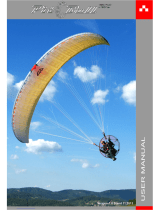
11
Landing
The Rapido 3 shows no unusual landing characteristics but as a reminder, here are some tips:
• Always set up for your landing early, give yourself plenty of options and a safe margin for error.
• Once below 30 metres avoid turning tightly as the glider will have to dive to accelerate back to normal
ight. If you are at low altitude, or if you hit sink, this could mean you hit the ground harder than
necessary.
• Lean forward out of your harness before the actual landing (especially if it’s turbulent), with your
weight leaning forward against the chest strap, and make sure your legs are ready for the landing and
a possible PLF (parachute landing fall).
• Allow the glider to y at hands up (trim) speed for your nal descent until you are around 1 metre
above the ground (in windy or turbulent conditions you must y the glider actively all the way). Apply
the brakes slowly and progressively to slow the glider down until groundspeed has been reduced to a
minimum and you are able to step onto the ground.
• In light winds/zero wind you need a strong, long and progressive are to bleed o all your excess
ground speed. In strong winds your forward speed is already low so you are aring only to soften the
landing. A strong are may result in the glider climbing upwards and backwards quickly, leaving you
in a vulnerable position.
• If the glider does begin to climb, ease o the brakes (10-20cm) - do not put your hands up all the way
- then are again, but more gently this time. Keep the brakes at mid speed, stand up, be ready to run
and make sure you brake fully as you arrive on the ground.
• Choose the appropriate approach style in function of the landing area and the conditions.
• In strong winds you need to turn towards the glider the second your feet touch the ground. Once
facing the wing pull smoothly and symmetrically down on the brakes to stall the wing. If the glider
pulls you, run toward it.
• If the wind is very strong, and you feel you might be dragged, or lifted again, stall the glider with the C
risers. This stalls the wing in a very quick and controllable way and will drag you less than if you use
the brakes.
• Always land heading into wind!





















